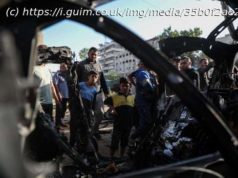Taking your breath away
The destructive power of these wildfire beasts surpasses words. But we’ll try.
Take, for example, the Camp Fire in Northern California. It’s still raging beyond control, has wiped out one entire town, devastated two others, destroyed nearly 10,000 homes and burned 140,000 acres. That’s 219 square miles or about the size of the entire city of Chicago.
Now the worst fire in state history, it’s not even half-contained. President Trump will visit the fire on Saturday.
A combination of drought, tinder-dry fuels, dry weather and high winds. And as the photo above shows, entire neighborhoods erased because too many homes were built close together without defensible fire perimeters.
An army of nearly 10,000 firefighters, many responding in speeding Interstate caravans of emergency vehicles from out-of-state, are fighting the flames around the clock. They’re spraying fire-retardant gell on homes and despite fierce winds, trying to hold the fire at nearby tree lines. Terrified wild animals and abandoned family pets flee through fire lines.
The sheriff announced Thursday that 63 bodies had been found so far by search crews and cadaver dogs. Some casualties were in scorched cars with melted tires apparently caught by fast-moving flames while trying to escape.
But a stunning 10 times that many people are still missing. Authorities hope many survived by fleeing and don’t know yet they’re being sought. But they fear for the worst.
We wrote here about what it’s like inside these wildfires, the smells, smoke and, above all, the eerie dragon-like roar of flames. And here’s a dramatic video with firefighters (strong language).
Just in the past week nearly a quarter-million acres (360 square miles) of California have burned, sending smoke and ash over hundreds of miles, canceling athletic events and raising health concerns as far away as San Francisco.
State officials said crews have battled more than 500 individual fire outbreaks in recent days, even halting traffic on major highways like Interstate 5 to let crews react quickly to wind-driven flames racing up mountainsides.
Scattered parking lots in Butte County are jammed full of motor homes, cars and tents of refugees. “We just had 10% of our county’s housing stock erased in one day,” said Ed Mayer of that county’s Housing Authority. “It’s hard to convey the significance of that.”
In Southern California, weather conditions are more favorable for fighting the major Hill and Woolsey Fires, the latter severely damaging famed Malibu. That was the largest one, covering some 98,000 acres so far, destroying 500 structures and claiming at least two victims. It is not yet two-thirds contained.






